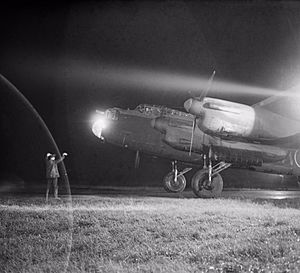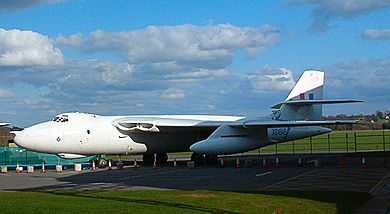No. 49 Squadron RAF facts for kids
Quick facts for kids No. 49 Squadron RAF |
|
|---|---|

No. 49 Squadron badge
|
|
| Active | 15 Apr 1916 – 18 July 1919, 10 Feb 1936 - 1 Aug 1955 1 May 1956 – 1 May 1965 |
| Country | |
| Branch | |
| Motto(s) | Latin: Cave canem ("Beware of the Dog") |
| Battle honours | Western Front, 1917-18*: Cambrai, 1917*: Somme, 1918*: Channel & North Sea, 1939-40: France & Low Countries, 1940: Invasion Ports, 1940: German Ports 1940 -45*: Ruhr, 1940 - 45*: Fortress Europe, 1940 -44*: Berlin, 1943-44*: Italy, 1943-44: Biscay Ports, 1943: Normandy, 1944: France & Germany, 1944-45*: Walcheren: Rhine: Honours marked with an asterisk are those emblazoned on the Squadron Standard |
| Insignia | |
| Squadron badge heraldry | A greyhound courant. The greyhound is indicative of speed. |
| Squadron codes | XU Apr 1939 - Sep 1939 EA Sep 1939 - Apr 1951 |
No. 49 Squadron was a special bomber squadron of the Royal Air Force (RAF). It was active from 1938 to 1965. This squadron was the first to use the Handley Page Hampden aircraft in September 1938.
The squadron became famous for a few reasons. One was when Rod Learoyd received the Victoria Cross medal in 1940. They also played a big part in Britain's atomic and hydrogen bomb tests. In 1956, during Operation Buffalo, a Vickers Valiant plane from the squadron dropped the first live atomic bomb for Britain. A year later, they were trusted with dropping hydrogen bombs in Operation Grapple.
Contents
History of No. 49 Squadron
The squadron first started in April 1916 at Swingate Down, England. In November 1917, they went to France. Their first mission was during the Battle of Cambrai. After the First World War ended, No. 49 Squadron became part of the forces occupying Germany. They were officially closed down in July 1919.
The squadron was started again in February 1936. This happened at RAF Bircham Newton, using planes from 'C' flight of No. 18 Squadron. They first used Hind aircraft. In March 1938, they moved to RAF Scampton. By September of that year, they began getting Hampden aircraft. This made them the first squadron to use these planes in operations.
No. 49 Squadron in the Second World War

During the Second World War, No. 49 Squadron carried out many important missions. On August 12, 1940, they attacked the Dortmund-Ems Canal.
In 1942, the squadron changed their planes. They first used Manchesters, then later Lancasters. In October, they led No. 5 Group in a daring attack. This was a dusk raid on the Schneider armament and locomotive works at Le Creusot.
In 1943, the squadron took part in the first "shuttle-bombing" raid. This meant they bombed targets like Friedrichshafen and La Spezia. They also participated in the famous raid on Peenemunde. In 1944, they attacked coastal gun batteries at La Pernelle in Normandy. They also targeted V-1 flying bomb storage sites. These sites were in caves at St. Leu d'Esserent, near Paris.
In December 1944, they joined a raid on the German Baltic Fleet at Gdynia. In March 1945, they helped bomb the defenses of Wesel. This allowed Commandos to take the town with very few losses.
Operations during the Mau Mau Uprising
No. 49 Squadron continued to use Lancasters until November 1949. At that time, they were given Lincolns. They completed two tours of duty during the Kenyan Mau Mau Uprising. These tours were from November 1953 to January 1954, and from November 1954 to July 1955. Squadron Leader Alan E. Newitt DFC led them during both tours. After returning to the UK, the squadron was closed down at RAF Upwood on August 1, 1955.
Accident of Avro Lincoln SX984
During their second tour in Kenya, Avro Lincoln SX984 was involved in an accident. This happened on February 19, 1955. The plane was returning from a bombing mission. The pilot flew the plane very low over a police hut in Githunguri. Another crew from No. 49 Squadron was visiting there.
On the third low pass, the plane hit the hut's roof and a telegraph pole. Part of the wing and nose broke off. The plane then climbed steeply, stalled, and crashed. This happened 8 miles north-northwest of Kiambu. Five crew members and four civilians on the ground died. A visiting crew member managed to pull the rear gunner from the wreckage. However, the gunner died a few hours later from his injuries.
An investigation found that the accident was caused by the pilot not following orders. He had flown too low without permission. There is a memorial window for those killed in the crash. It is located in St Leonard's Church, Sandridge in Hertfordshire, UK.
No. 49 Squadron and the Vickers Valiant
No. 49 Squadron used the Vickers Valiant aircraft. They operated these planes from RAF Wittering and RAF Marham. This period lasted from May 1, 1956, until May 1, 1965.
Nuclear Testing Missions

.

Operation Buffalo
In autumn 1956, No. 49 Squadron took part in Operation Buffalo. This involved British nuclear tests at Maralinga. During the Buffalo R3/Kite test on October 11, 1956, a Vickers Valiant (WZ366) from No. 49 Squadron made history. It became the first RAF aircraft to drop a live atomic bomb.
The bomb landed about 100 yards left and 60 yards short of the target. It exploded at a height of 150 meters at 3:27 PM. The bomb's power was about 3 kilotons (ktonTNT). The pilot, Squadron Leader Edwin Flavell, and the bomb aimer, Flight Lieutenant Eric Stacey, received the Air Force Cross for their bravery.
The radioactive fallout from this test was very small. Two clouds formed after the explosion. A low cloud stayed within the restricted area. A higher cloud spread a tiny amount of fallout over parts of Australia.
Operation Grapple
No. 49 Squadron also dropped seven of the nine nuclear bombs used in Operation Grapple. These tests happened in 1957 and 1958. They took place at Malden Island and Kiritimati (Christmas Island) in the Pacific Ocean. These tests were part of Britain's hydrogen bomb programme.
No. 49 Squadron had eight Valiants, but only four were sent for the tests:
- XD818, flown by Wing Commander Kenneth Hubbard, the squadron commander.
- XD822, flown by Squadron Leader L. D. (Dave) Roberts.
- XD823, flown by Squadron Leader Arthur Steele.
- XD824, flown by Squadron Leader Barney Millett.
The other four Valiants stayed at RAF Wittering. They were used to carry bomb parts.
A full practice for Operation Grapple was held on May 11. On May 14, it was decided to do the Grapple 1 test the next day. Wing Commander Hubbard flew the Grapple 1 mission in XD818. Squadron Leader Millett flew XD824 as an observation aircraft.

The two bombers took off from Christmas Island at 9:00 AM. The bomb was dropped from 45,000 feet. It was dropped off the shore of Malden Island at 10:38 AM local time on May 15, 1957. Hubbard missed the target by 418 yards. The bomb's power was estimated at 300 kilotons (ktonTNT). This was much less than it was designed to be.
Remaining Aircraft
Only one Vickers Valiant (XD818) aircraft still exists. This is the very plane that dropped Britain's first hydrogen bomb. It was part of Operation Grapple with No. 49 Squadron. You can see it at the RAF Museum Cosford, near Wolverhampton.

